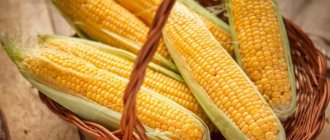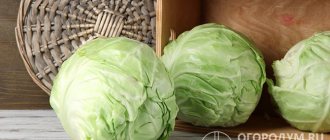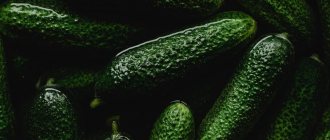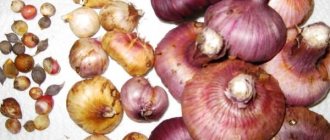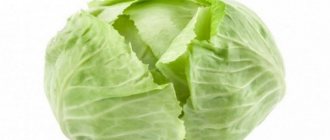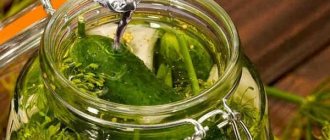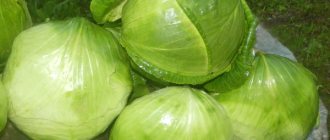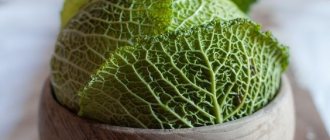Heads of mature hybrids can be stored for 8-12 months. The average shelf life of cabbage is 3-6 months, depending on the place of cultivation, variety and storage conditions. Taking into account the biological characteristics of cabbage varieties of different ripening periods, the storage duration can be: 1-3 months for early-ripening hybrids, 4-5 months for mid-ripening and mid-late ripening hybrids, and 6-8 months for late-ripening hybrids.
Optimal storage conditions for white cabbage:
Product temperature: −1 - +1.5 °C Relative humidity: 90 - 95%
Cabbage does not have deep and long-lasting dormancy and the ability to repair leaf damage. An important feature of cabbage is its relative resistance to short-term exposure to negative temperatures. Heads of mature varieties can withstand autumn frosts down to −5°C while still standing. Felled heads of cabbage are less resistant to frost; repeated frosts are especially destructive for them.
It is advisable to harvest cabbage intended for storage in the phase of physiological rather than biological maturity and in dry weather. Premature harvesting can lead to excessive wilting, and late harvesting causes cracking of cabbage heads; replanting frozen cabbage is not allowed. The stump of the head of cabbage should be cut slightly below the attachment point of the covering loose leaves, the cut should be clean, trimming the stump is necessary to protect the heads of cabbage from mechanical damage during transportation. The length of the outer stump of cabbage for direct sale should be 1 cm, and for storage - up to 3 cm.
Cabbage is placed in containers directly in the field and placed in a vegetable storage facility on the same day. It is recommended to store only late varieties of cabbage with dense heads and tightly fitting 2-3 leaves. Heads of cabbage intended for storage must be fresh, whole, unsprouted, healthy, not contaminated with soil and without excessive external moisture. When storing cabbage for long-term storage, you should carefully discard heads of cabbage that are severely damaged mechanically, as well as those affected by pests and diseases. Heads of cabbage should be selected that are leveled and of medium size. At the harvesting stage, it is important to prevent injury to the heads of cabbage.
.
Cabbage does not heal
, damaged leaves evaporate a lot of water, and loss of marketable qualities occurs.
During storage, cabbage heads generate a significant amount of heat and moisture.
, in similar conditions - approximately twice as much as potatoes.
Cabbage easily warms itself and is a leader in moisture release. The optimal storage temperature for edible cabbage is 0. +1°C. Short drops to -1.5 °C are not dangerous, but it is not recommended to allow them for a long time - this can lead to the formation of “cuffs”. Nebula - darkening and decomposition of the internal parts of the head of cabbage. In this case, the inner zone of the heads of cabbage dies off due to a lack of oxygen, the penetration of which is prevented by layers of ice formed between the leaves. In dense cabbage varieties, “cuffs” form much faster than in loose cabbage varieties.
Relative humidity during cabbage storage should be maintained within 90-95% and it is usually high due to intense moisture release. In the space between the heads of cabbage in a stack it approaches 97-98%, and in the atmosphere of the storage it fluctuates between 93-96%. Such high relative humidity helps preserve the mass of heads of cabbage
, since moisture loss due to evaporation under these conditions is small.
Immediately after laying the chambers, it is necessary to begin cooling the products and bringing them to storage temperature. With active ventilation, this is only possible using low night temperatures, so cabbage is harvested and planted when temperatures drop steadily to zero; freezing to −3 °C is not a problem. The main task of ventilation during the main period is to remove heat and prevent condensation. The intensity of ventilation in cabbage storage facilities is 2 times higher compared to potatoes.
Cabbage that is frozen but not frozen during harvesting can be stored under optimal conditions for 2-3 months. Such heads of cabbage must be stored in separate sections or compartments and the temperature in the cabbage layer must be immediately reduced to 0.−1 °C. Frozen cabbage is sold first.
Calculated values of heat and moisture release and bulk mass of products for cabbage
Heat release rate of vegetables (for cabbage)
Calculated parameters of internal air when designing the enclosing structures of a storage room for winter operating conditions (for cabbage)
Temperature, humidity and gas conditions. Maximum storage time for vegetables (for cabbage)
Calculated values of heat and moisture release from vegetables (for cabbage)
Do you want to save as much as possible?
harvest with minimal energy and resource consumption?
What sub-zero temperatures can cabbage withstand?
If the question refers to what sub-zero temperature cabbage seedlings can withstand, then we can say that hardened seedlings of cauliflower and white cabbage can withstand frosts down to -3 - -4 degrees Celsius. I would like to emphasize that these are hardened seedlings, but if you planted greenhouse seedlings and then frost struck, they will not survive such a temperature.
Description of culture
Belongs to biennial plants of the cruciferous family. It has a tall, leafy stem.
In the first year, a basal leaf rosette grows, which is widely used in cooking, cosmetology, and folk medicine, and in the second year the seeds are obtained.
The leaves are glabrous and usually have a grayish-green or bluish-green color. In the lower tier they are quite large, fleshy, with strongly pronounced veins. Due to the fact that they fit tightly to each other, a head of cabbage is formed around the stem. The part of the stem located in the head of cabbage is called the stalk.
Cabbage flowers are large, in a multi-flowered raceme and yellow in color. The seeds are located in pods that reach a length of 10 cm. The seed is dark brown in color and has a spherical shape, up to 2 mm in diameter.
Saving the crop after the effects of frost
Is cauliflower afraid of autumn frosts? Cauliflower is known among other vegetables for being extremely heat-loving.
If the ambient temperature drops below 8-10˚ C, then small heads begin to form at the base of the white inflorescence, which will subsequently become spare shoots. The development of the main inflorescence will most likely stop.
With the onset of cold weather, the growth of cauliflower slows down significantly, which requires immediately sending them for ripening at home. Severe frosts can damage cabbage heads, but it is still possible to save them with the help of greenhouses.
This is easy to implement only if a stable temperature of 10° C is maintained inside.
The main ways to protect plants from spring and autumn frosts are:
- Smoking is the most ancient method, which involves lighting fires at different points in the area. The resulting warm smoke screen softens the negative impact of lower temperatures on seedlings. Smoking is carried out exclusively in calm weather, so that the smoke spreads close to the ground and maintains a warm protective layer of air. They start lighting fires already at 0°. Now this method is being abandoned everywhere, because... it has been proven to be unsafe and not environmentally friendly.
- Sprinkling is one of the most common ways to protect plants from freezing. Sprinkling involves uniformly spraying the plantings with warm water through a fine sprayer. As the water freezes, the heat needed for seedlings will be released. This method is effective only in calm weather at temperatures down to -3-4°. In strong wind conditions, sprinkling will only harm the plants. Before frost sets in, you can water the soil so that the sun's rays heat the moist soil during daylight hours, and at night it gives off heat and creates a favorable microclimate for the seedlings.
- Creating a thermal insulation layer - covering plants with newspapers, cardboard, fabric to retain heat. The more layers are created, the more reliably the seedlings will be protected from the cold. The covering material should not come into close contact with the sprouts; it is imperative to maintain an air gap. The thermal insulation layer will make it possible to survive a drop in temperature (below 0°) for up to a week.
- Foliar fertilizing with fertilizers containing potassium and phosphorus is an effective means of withstanding cold (down to -5°). To increase the winter hardiness of plants, fertilizers should be applied at least a day before the onset of cold weather.
Severe frost can kill crops. Weak and medium long frosts lead to rotting of the leaves of cabbage heads and loss of useful substances. Cabbage caught in frost does not have crispness.
Saving seedlings
Is white cabbage afraid of frost? White cabbage is not afraid of the first frosts, but there is still no need to delay harvesting. The longer the heads of cabbage lie in the cold, the worse they will be stored.
If a person does not have time to cut down all the cabbage before the temperature drops below -5 degrees, then it can quickly deteriorate.
Such heads of cabbage will have to be put into use immediately - frozen or fermented. In its entirety, it will not last more than a month. And if you harvest late cabbage too early, the leaves will begin to wither and will also not allow the harvest to last all winter.
Cauliflower is light-loving and cold-resistant. When adapted to the open air, adult seedlings can withstand short-term temperature drops to -4°C-5°C. If the cold snap is prolonged, the leaves acquire a purple tint, and the growth of the vegetable slows down significantly.
In early cabbage, the heads can no longer withstand -2°C-3°C; for late cabbage, colds down to -5°C are destructive.
Temperature conditions also affect the formation of heads. At 21°C this takes 10-12 days, and at 13°C-15°C it takes 21-23 days. In conditions of 4°C-5°C there is practically no growth. Low temperatures have a more depressing effect on the plant than high temperatures.
WILL CABBAGE SURVIVE A FREEZE OF MINUS FOUR DEGREES. Video by Olga Chernova May 2, 2022
HOW CABBAGE SURVIVED THE FROST OF MINUS 5 DEGREES. Video by Olga Chernova May 6
FROST - 2 DEGREES CABBAGE WILL TOLERATE WITHOUT COVER! Olga Chernova.
What are the benefits of cabbage?
The leaves of this vegetable contain carbohydrates, proteins, fiber, polysaccharides, phytoncides, carotene, enzymes, vitamins A, B1, C, P, K, B6, etc. The vegetable is also rich in mineral salts: potassium, phosphorus, calcium and sulfur.
In folk medicine it is used in the treatment of purulent wounds and ulcers, gastritis, high blood sugar, constipation, etc. Using cabbage juice, excess fluid is removed from the body.
In cosmetology, cosmetic masks and rinses for facial skin are made based on cabbage juice.
Optimal temperature
The most optimal temperature at which cabbage can grow normally depends on the age of the seedlings.
- When the seedlings have not yet appeared, the optimal room temperature is 18-20 degrees.
- If seedlings have already appeared, then the temperature can be reduced to 9-10 degrees during the day and 8-9 degrees at night during the first week.
- In subsequent days, it is best to maintain the temperature at 10-15 degrees.
These figures are averages, but keep in mind that everything may vary somewhat depending on the plant variety. For example, for cauliflower, you can raise the temperature by about 5 degrees.
Germination temperature can vary widely. Even at a temperature of 3-5 degrees, the seeds will still be able to germinate (for some varieties you can even lower it to -5 degrees, but it’s better not to risk it and focus on average values). More or less optimal temperature, in this case, can be considered 15-18 degrees. So don't worry too much about the temperature at this stage, as long as there are no changes.
We recommend watching this video on the topic:
Types and varieties of cabbage
There are the following types of cabbage:
- - cabbage;
- - colored;
- - kohlrabi;
- - Savoy;
- - leafy;
- - Beijing;
- - Chinese.
Cabbage
There are the following types:
- - white cabbage;
- - red cabbage;
- - Brussels.
The most popular type is white cabbage, which produces a head of light green color. In order to increase the period of use of fresh vegetables, varieties with different ripening periods have been bred. The most common early varieties (ripening - from 70 to 120 days): Iyunskaya, Kazachok, Parel, Golden Hectare, etc. Of the mid-season varieties (ripening up to 140 days), the most popular are: Slava, Sugar Queen, Kupchikha, Atria, etc.
For long-term storage, late-ripening cabbage is used. Most often, gardeners grow the following varieties: Aggressor, Amager, Kolobok, Mara, Moskovskaya late, Belosnezhka, Megaton F1.
Red cabbage leaves have a burgundy-purple color. Early-ripening, mid-ripening and late-ripening varieties are grown. The most popular are Kalibos, Stone Head. Mars, Langedijker, etc.
Brussels sprouts have small heads around the stem that can be eaten fresh, stewed, canned, or frozen. Common varieties: Franklin F1, Long Island, Merry Company, etc.
Late varieties of cabbage are harvested in late October - early November (depending on the region). In this regard, the relevant question is how the plant tolerates low temperatures, and whether cabbage is afraid of spring frosts.
Attention! An adult plant can easily tolerate cold and is not afraid to freeze even if the temperature drops to -7°C.
Cauliflower
It is an annual plant. In cooking, they use the head, which consists of fleshy flower shoots located tightly to each other.
The following types are distinguished:
To preserve nutrients in winter, canning or deep freezing is used.
The most popular varieties of cauliflower are Snow Globe, Regent, Express, White Beauty, etc.; broccoli – Lord, Fiesta, Gnome, Agassi, Marathon, etc.
Kohlrabi is a biennial plant with a stem at the bottom that looks like a turnip. The most popular varieties are early ripening Piquant, Smak, Violetta, etc.
Savoy cabbage has a loose head, with loosely fitting leaves. Vienna early, Golden early, Vertu, Melissa, and Alaska are popular in gardens.
Kale is a biennial plant. In the first year, a short stem is formed. In the second year, a peduncle appears. Grown for decorative purposes and for culinary use. It may not freeze even if it is frosty outside, reaching -15°C.
Chinese cabbage is grown for one year. Forms a head or leaf rosette. Favorite varieties of gardeners are Russian size, Marfa, Victoria, Cha-cha, etc.
Storage conditions and periods - summary table
| Conditions | Shelf life (months) |
| In earthen trenches | 7-8 |
| In the basement/cellar | 9 |
| In a refrigerator | 1-2 |
| In the freezer | 9-12 |
| On the balcony | 4-6 |
| Dried | 12 |
The indicated values are valid for crops of late varieties, provided that the vegetable is properly harvested and storage conditions are observed.
Growing cabbage seedlings
Any type of cabbage can be grown in seedlings or without seedlings. The seedling version is mainly used.
The main advantage of this method is that you can get an earlier harvest by planting seeds earlier. Thus, cabbage that is grown in seedlings has a certain race, compared to that which is grown without seedlings, which is determined by the age of the plants and the phases of its development.
Sowing is carried out in beds in greenhouses or in seedling boxes located indoors. Depending on the type of cabbage, the following planting dates for cabbage are usually followed:
- early - from the beginning to the end of March;
- average – end of March – end of April;
- late – mid-April.
Savoy cabbage seeds are sown from the second half of February (for early varieties) until April, Brussels cabbage seeds - in April, the cauliflower planting period is March-April.
Cabbage shoots usually appear quite quickly. Plants begin to sprout approximately 10 days after sowing.
After warm weather sets in, young plants need to be planted in the ground, where they will grow in a permanent place. The optimal temperature range for planting is +10-15°C.
Planting cabbage seedlings
When transplanting seedlings to a permanent location, the strongest and most developed plants are selected, which allows for a good harvest from the site in the future.
Planting is usually carried out in May (depending on the region), but frosts are possible during this period.
Cabbage is frozen in the garden, what to do?
It often happens that the gardener does not have time to protect the crop from night frosts and the cabbage is still exposed to negative temperatures.
In this case, naturally, the question arises of what to do if the cabbage is frozen. Experienced gardeners advise:
- If the exposure to sub-zero temperatures was short-term, then the forks should be collected and moved to a cool (not hot) place. Wait until they thaw, then remove the top leaves. This crop is not suitable for long-term storage, but the vegetable can be eaten immediately or processed.
- If the head of cabbage is completely frozen, the situation is worse. However, in this case, you can try to use the crop. Some housewives cut out the stalk and then ferment the vegetable. It is believed that it will ferment even faster, but the taste will differ from the standard one.
A very interesting question is whether it is possible to salt cabbage that is frozen. Some housewives give a positive answer. But you need to carefully remove all rotten parts and prevent re-freezing. Well, the taste of such pickles will be worse; you won’t be able to achieve the usual crunch.
When growing cabbage on your own plot, you definitely need to understand the issue of hardening off the seedlings. Otherwise, sudden frosts can destroy the entire crop.
Cabbage and frost
In various regions, the period of possible cooling may last until mid-June.
Whether cabbage seedlings are afraid of frost, what kind of frost cabbage can withstand in the spring, and how low temperatures can affect the quality of the crop depends on what type and variety was chosen for cultivation.
Temperature limits for use
Plant seedlings with the seedless growing method die at -3°C. If the seedlings were grown in cold greenhouses or were pre-hardened before planting in the garden, then they can withstand a short-term decrease in temperature to -5°C, but in this case the total weight and quality of the finished heads of cabbage decreases. If the temperature outside drops below -5°C, the seedlings die.
Reasons for freezing cabbage
Let's consider the reasons for the death of cabbage during frosts. Both frost and heat are harmful to the development and life of cabbage seedlings in spring.
If the air temperature drops below 0°C, the water in the plant cells freezes and turns into ice. From the physics course we know that if water is frozen, then when it freezes it increases in volume. The same thing happens in plants. When frozen, the liquid ruptures the seedling cells from the inside, and the cabbage dies. Sudden thawing after sunrise is especially dangerous for plants.
You can't let it thaw
The influence of low temperature can aggravate the wrong choice of planting site, as well as the condition of the seedlings.
Risk areas for cabbage
Do not plant plants on heavy soils or in lowlands. Light loamy areas well protected from the wind are suitable for it. In addition to the fact that there is constant stagnation of moisture in the lowlands, the air during frosts is also 2-3°C lower than in the flat areas.
For optimal plant development, the soil should not be acidic. On such soils, cabbage will not be able to develop normally, it will get sick, and the fertilizers that you apply will not be able to be completely absorbed by the seedlings. Therefore, if the soil on the site is acidic, then it needs to be limed. Dolomite flour is perfect for these purposes, as it will additionally enrich the earth with potassium. If flour is not available, you can use chalk, ash or lime. Only lime can be used exclusively during autumn digging, so as not to damage the seedlings.
If the acidity level is increased, then the soil is treated with lime
Whether cabbage is afraid of spring frosts, and how affected the seedlings will be, also depends on the general condition of the plants. If they are healthy, have managed to strengthen and grow well, then the seedlings will recover from stress much faster and the damage to the crop will be minimal.
To grow healthy seedlings, you need to maintain temperature conditions. The optimal range is 12-20°C. Higher temperatures lead to seedlings beginning to lag behind in development, becoming weak and not as viable.
Region and climate
Weather is one of the main factors affecting the health, growth and yield of cabbage beds. Based on its regional differences, agrotechnical techniques appropriate to the region are used in growing vegetables.
In the Moscow region, high cloudiness prevails, which is why a vegetable in need of good lighting may not receive the required number of hours of sunshine. In addition, unstable weather conditions in the spring can hinder the development and strengthening of seedlings, which is why when growing outdoors they resort to the method of warm beds. Due to the low rainfall during the summer season, you will need to ensure that the seedlings receive a sufficient amount of water. The most suitable varieties for this area will be cabbage of early, medium and mid-late ripeness: species that ripen later may not have time to ripen.
The Siberian climate, known for its harshness, does not make it possible to grow the white cabbage variety from seeds in an open area, so seedlings are used in this region. Late-ripening varieties will not be able to form mature heads of cabbage during a short summer, so cabbage of mid-late and medium maturity is recommended for cultivation in this area. In Siberia, seedlings are placed in open areas only in late May, protecting them from the cold for some time.
Growing cabbage in Siberia
Strong winds and sudden changes in temperature in the Urals can result in snowfall in October and night frosts in May. Cold weather can destroy seedlings, so cabbage sprouts are grown in greenhouse conditions, at room temperature, or using the warm bed method. They are planted in the garden in early or mid-May. At first, to protect the crop from night frosts and garden parasites, it is covered with dense agrofibre. To prevent soil freezing, the soil between the rows is mulched with black film.
Resistant seedlings of white cabbage
Is young broccoli afraid of frost, and how many degrees can seedlings of other types of cabbage withstand?
Seedlings of cauliflower, Beijing and broccoli can withstand short-term frosts down to -2°C.
However, cabbage is exposed to low temperatures not only in spring, but also in autumn, since autumn is harvest time. White cabbage is usually harvested in late October - early November (depending on the region).
For adult plants, the lower permissible temperature limit, compared to young plants, is slightly pushed back. For example, white cabbage can withstand cold down to -7°C, cauliflower - up to -5°C. It is even recommended to remove the heads of cabbage from the site after frosts begin. After freezing, cabbage leaves lose their bitterness and the vegetable tastes sweet.
Cabbage turns sweet
Lowest temperature for cabbage. "Lend your shoulder"
The main growth of heads of cabbage occurs not in the summer, but in September-October. They begin to set when there are eight or nine covering leaves. Sometimes inexperienced gardeners remove the top leaves in the fall and... ruin the “pantry”. The “naked” cabbage begins to build up its “clothes” again, that is, it spends its energy on things other than what is required for the season. As a result, for the winter it will be laid down “frail”, loose, without a hard head of cabbage, as it should be.
Instead of “undressing” the cabbage, today is the time to help it get stronger. For example, it is very important now to loosen the soil around the vegetable. Moreover, this must be done right up to harvesting, since then it is easier for the leaf to fill with carbohydrates and salts. Attention: the more leaves, the more nutrition the plant will receive. In addition, you need to pollinate the cabbage weekly with ash on wet leaves (so that it does not fall off), not forgetting about the soil. This is done both for feeding and against pests, which are also not dormant, despite the cool weather.
Methods of frost protection
In order not to worry about whether or not cabbage seedlings are afraid of spring frosts, and how to avoid freezing young plants, it is best to cover the seedlings after planting. To do this, a greenhouse is installed above them. The film can be opened during the day to keep the plants cool, and closed at night. You can also protect the plantings using cut plastic bottles that cover each seedling. Protection of seedlings should be mandatory if early planting of plants on ridges is planned.
To ensure that seedlings are not damaged by exposure to low temperatures, it is necessary that their leaves do not touch the covering material.
Attention! A low level of protection of young plants from spring frosts can lead to the death of the plantation.
If there is a threat of cold weather, you can cover the seedlings with old newspapers, buckets, plastic bags, boxes, etc.
If severe frost is expected, you can use plant irrigation. It is usually done at night a few hours before the onset of low temperatures. In this case, the cold water evaporates from the ground, the temperature rises slightly, and the cold air does not sink to the soil surface.
Mulching or planting seedlings on warm ridges will also help to protect plants well.
If your plants were not protected, then you can help your cabbage survive frost in the following ways:
- Early in the morning, you need to spray the damaged leaves with cold (not warm) water and shade them so that the plants thaw more slowly. This thawing will slightly soften the effects of frost.
- The use of special antidepressants - chemicals that are sprayed on damaged plants - has proven itself to be effective.
Also, to increase the tolerance of seedlings to low temperatures, the plants need to be hardened off beforehand.
Hardening off seedlings
A preventative measure is hardening off young plants. During the hardening process, seedlings are gradually accustomed to life at lower temperatures. Hardened plants tolerate frost much better than those that grew constantly at elevated temperatures. It is hardened seedlings that can withstand frost down to -3°C, while unhardened ones die at this temperature.
Hardening of seedlings using ventilation
For hardening, about half a month before planting on the ridges, boxes with seedlings begin to be taken outside during the day in warm weather, gradually increasing the time spent in the fresh air. Daytime air temperature should fluctuate between +12-15°C, and nighttime temperature should not exceed +8°C.
2-3 days before planting, seedling boxes do not need to be brought into the house. But this is done only if frost is not expected outside.
If the cabbage is caught in the frost. Different opinions on pickling frozen cabbage
Different housewives' opinions on whether it is possible to ferment frozen cabbage may differ radically. Some say that frozen vegetables can no longer be used for pickling. They believe that such cabbage, if fermented, will turn out too soft and will not have a crunch. Others have a different opinion on this matter.
Much of the suitability of such cabbage for further pickling depends on the condition of the head of cabbage after defrosting. An important point is how long the vegetable was frozen. And sometimes it happens that only the top leaves of the head of cabbage are frozen. In this case, you just need to remove them and use the rest of the cabbage for processing.
Sometimes it happens that housewives do not have time to salt the heads of cabbage that are stacked on the veranda or balcony and are intended for further processing. If this cabbage freezes with the onset of cold weather, you should not immediately bring it into a warm room. It is better to defrost the heads of cabbage gradually in a cool place. When they thaw, it is possible that the cabbage will remain the same in texture or just a little softer than fresh.
It happens that only the top leaves of the head of cabbage are frozen. It is enough to remove them and use the rest for fermentation. But the head of cabbage can be completely frozen. It is necessary to remove damaged and rotten leaves, cut or drill out the stalk, after which this cabbage can be fermented. If the cabbage leaves are too flabby after defrosting, it is better to use them for current cooking rather than for pickling.
You can ferment cabbage that has been frozen in the same way as regular fresh cabbage:
- whole heads of cabbage;
- halves or quarters of heads of cabbage;
- shredded with or without various additives.
Frozen cabbage often ferments even faster than fresh cabbage. For 10 kg of vegetables take 200-250 g of salt. If the frozen cabbage juice released during the ripening process is not enough, you can add a little salted water.
Frozen cabbage may still be suitable for fermentation. Of course, this is possible if it has not become too flabby and the rotting processes have not affected the entire head of cabbage. As an independent dish, such sauerkraut will not be so good, but it will be suitable for preparing first and second courses.
Experts' opinions on whether frozen cabbage is suitable for pickling vary. Some people believe that frozen vegetables are not suitable for pickling. Others claim that such cabbage will be soft but tasty if the vegetable is properly salted. Of course, the cabbage will no longer be crispy. But such a product will perfectly complement any dish, for example, borscht, cabbage soup or vinaigrette.
In this case, the taste of the treat will depend on how long the vegetable was frozen. If the heads of cabbage froze during a sharp frost, perhaps only the top leaves were damaged, but the inside of the vegetable remained suitable for cooking.
Attention! Cabbage leaves that have been frozen once are suitable for pickling. If a vegetable has previously been defrosted, it should not be used for pickling.
The product loses its usefulness, dense sheet structure, taste, and putrefactive processes may develop inside.
If you still have doubts about whether it is possible to ferment cabbage if it is frozen, you should familiarize yourself with the recipe for pickling such a product.
You can salt frozen cabbage for the winter in several ways:
- whole heads of cabbage;
- halves and quarters of vegetables;
- shredded sheets with the addition of spices and herbs.
At the same time, fermenting frozen cabbage is even faster than fresh cabbage. Thanks to softer sheets, the product preparation time is reduced several times. For 10 kilograms of vegetables you will need approximately 200-250 grams of rock salt. If little juice is released during ripening, you can add salted boiled water to the preparation.
Completely frozen heads of cabbage can also be suitable for pickling, unless they have begun to rot and become too soft. It is not recommended to ferment such a vegetable for the winter, but it is suitable for preparing first courses, vegetable stews, meat with vegetables, or stewed potatoes with sauerkraut.
Comparison of frost tolerance
Currently, gardeners, in addition to cabbage, grow a number of frost-resistant vegetables. For example, onion seedlings do not die when frozen to -3°C, onion seedlings - at -7°C, celery - -4°C, parsley - -8°C, etc.
For zucchini seedlings, the temperature is +0.5°C, cucumbers - -1°C, peppers die at 0°C, and tomatoes - at 1.5°C. Taking into account the fact that cabbage seedlings do not die at -5°C, and adult plants tolerate temperature drops down to -7°C, we can say that in terms of frost resistance it is among the vegetable leaders.
Thus, to obtain a good harvest, it is necessary to properly grow seedlings and protect plants from exposure to low temperatures in spring. Then the table will have tasty and healthy cabbage that you grew on your own plot.
How to Preserve Different Varieties of Cabbage
If Soviet summer residents mainly grew white cabbage, now in the ridges you can find cauliflower, broccoli, kohlrabi, and Chinese cabbage. Not all of them are as easy to store as the white and green “koloboks” we are accustomed to from childhood, but their life can be extended.
How to store white cabbage
White cabbage is one of the easiest vegetables to store. It easily tolerates changes in temperature and humidity, does not require a separate room, and even lies in a room or on the balcony for a long time.
If you follow the basic conditions for storing cabbage (temperature from –1 to 2°C, and humidity – 85-95%), then it will easily last for more than six months. It is also important not to forget to regularly (at least once a month) ventilate the room with the heads of cabbage and sort through them in search of rotten ones.
How to store cauliflower and broccoli
Cauliflower and broccoli heads are not as durable - they can be stored for a maximum of several months. If you want to enjoy dishes from these vegetables all winter, it will be easier to separate them into florets and freeze them. Fresh cabbage can be placed in wooden boxes covered with film and stored in the cellar. At the same time, it needs to be checked every couple of weeks and removed from storage at the first sign of rot.
Cauliflower can also be stored in the refrigerator, but to prolong its life, each head will need to be placed in a separate bag or wrapped in cling film.
How to store Chinese cabbage
Properly selected humidity and storage temperature for cabbage will extend the life of even the capricious Beijing beauty. It can lie for up to 3 months if it is provided with a humidity of about 95-98% and a temperature of 0 to 2°C. True, even slight fluctuations in any of these parameters will lead to rotting or withering of tender leaves.
Causes of freezing
The threat of freezing to plants depends on several factors:
- climatic conditions at the time of cultivation;
- condition of seedlings;
- topographical location of the landing site.
External climatic conditions include sudden changes in weather phenomena - an abnormal drop in temperature or increased humidity with a cold wind.
The condition of the seedlings determines its health and the hardening carried out. A weakened and unhardened plant can die even from a slight cold snap.
Risk area
Low-lying areas are at risk of freezing (especially if there are bodies of water and marshy soils nearby). Areas well heated by the sun's rays have a better chance of growing productive crops.
It should be taken into account that frost resistance depends on the cabbage variety. Let's consider whether cauliflower is afraid of autumn frosts. Cauliflower is the most demanding in terms of temperature conditions. Cabbage and broccoli are quite unpretentious, and Brussels sprouts can withstand down to -10°.
Beijing cabbage is afraid of frost. What is the best way to grow Chinese cabbage - seeds or seedlings?
By the way, we said that Chinese cabbage can be grown in two ways: by sowing seeds directly into the ground and through seedlings, that is, first grown indoors and then in the ground. We can immediately say that growing Chinese cabbage by sowing seeds in the ground is also a good method, but it is advisable for residents of the southern regions to use it, while residents of central and cooler regions should first take care of growing seedlings. But in this material we will definitely talk about both methods of growing Chinese cabbage.
Growing Chinese cabbage through seedlings
Let's start with seedling germination. What is important here and needs to be remembered? Firstly, seeds for seedlings can be sown twice a year, that is, the first time around mid-March or after a couple of days, and the second time around mid-June, but with a shift towards July even by a couple of days.
The second harvest of Chinese cabbage (summer) usually stores better than the first. Remember: the crop is capricious in terms of harvesting and suffers for a long time in the planted area, it takes root slowly, so we recommend sowing the seeds directly into peat-humus pots, from which you will not have to replant. The pots decompose when planted in the ground, so the root system is not damaged and the seedlings take root faster.
It is best to fill the pots with a mixture of completely decomposed organic matter, turf, river sand and garden soil in equal proportions with the addition of 500 g of wood ash per 10 kg of substrate. When planting bok choy, water the soil lightly and drill the seed down an inch, no more. Next, place the pots with seeds in a room with room temperature (+ 20... + 22).
If you want Chinese cabbage seeds to germinate faster, then before sowing, soak them for a day in gauze soaked in any safe growth regulator - epin, heteroauxin, etc., then place the pots with seeds on the bottom of the box and cover the food box with film.
Try not to change the temperature in the room; spray the surface of the soil in pots with a spray bottle, preventing it from drying out. If everything is done correctly, then in four days, and sometimes earlier, Chinese cabbage sprouts will appear. Immediately after their appearance, the film must be removed and the containers placed on the southern windowsill.
Caring for Chinese cabbage seedlings consists of watering (taking into account soil moisture) and providing the plants with a daytime of 12-13 hours, no more. LED lamps are suitable for additional lighting.
After the appearance of four to five well-developed leaves, which are usually observed in Chinese cabbage after 25-30 days, the seedlings (after a week of hardening) can be planted on the site.
Hardening is an important stage; it consists in the gradual adaptation of plants to more severe conditions. It's great if you have an enclosed balcony or veranda. When the plants have the appropriate number of leaves, the seedlings can be removed for a couple of hours; the next day, the time the seedlings stay on the balcony or terrace can be doubled, and then this time can be increased to a day.
After hardening, it is allowed to plant Chinese cabbage in beds; to do this, it is necessary to assemble a loose bed, always well lit, without stagnant irrigation water. When planting, be sure to take into account the crops that previously grew in this bed; for example, Chinese cabbage grows noticeably after onions, garlic, carrots and potatoes, but after cruciferous vegetables it does not grow well.
Growing Chinese cabbage without seedlings
To do this, you first need to prepare the soil, however, as when planting seedlings in open ground, dig a shovel with a full bayonet, break up the lumps, loosen, making sure that the bed is occupied by worthy predecessors or the land was uncultivated.
After the beds are placed in an ideally lit place, devoid of any, even slight shadow, it is necessary to sow Chinese cabbage seeds in holes or grooves, deepening each centimeter by two, no more. After sowing, it is recommended to water the soil either from a spray bottle or from a watering can, but with a spout with very small holes.
Important! Be sure to space the seeds and plant the bok choy seedlings at the optimal spacing, usually 35cm between plants and 40cm between rows.
If you sow Chinese cabbage in dry weather, after watering the surface of the soil, in order to retain moisture as much as possible, it should be lightly sprinkled, literally sprinkled with wood ash, stove ash or soot. If the weather is cool and there may be frost, the crops should be covered with a transparent film. When sowing seeds in open ground, seedlings will have to wait twice as long as sowing in peat-humus cups.
Preparation for storage
In order to preserve the beneficial properties and increase the shelf life of cabbage, you need to take a number of precautions.
Remove the heads of cabbage in a timely manner
The daytime temperature to start harvesting cabbage should be within 2–8 degrees; at night there may be light frosts, but not lower than -3 °C. If we remove the heads of cabbage earlier, they will quickly begin to deteriorate and crack.
Properly cutting cabbage for storage
Prepare a sharp, durable knife for cleaning. The heads of cabbage need to be cut off, leaving stalks 2-3 cm long. If we hang the cabbage for storage, then we don’t need to cut the stalks, you can even leave the roots, they will slow down drying.
Clean off dirt and remove top leaves
Clean the heads of cabbage well from the soil. Leave 2–3 leaves to protect against mechanical damage and diseases, remove the remaining upper leaves.
Sort carefully
Select dense, even, firm, whole heads of cabbage. Discard underdeveloped heads of cabbage. Check the heads of cabbage for mechanical damage and cracks. Forks affected by pests are also no good; we will send them for processing, pickle them or marinate them.
What negative temperatures can cabbage withstand?
At what temperature does cabbage freeze in the garden in the fall depends on its type. This parameter is directly related to the density of the pulp and growing conditions.
- White cabbage. The situation in which cabbage is frozen and something needs to be done about it occurs after -5 °C for white cabbage. If the time for collection comes, it can withstand a decrease in the parameter by another 5 °C.
- Beijing. This species is less resistant to frost and will only tolerate -2 °C. A mature plant will not deteriorate down to -5 °C.
- Colored. Despite the dense pulp, the inflorescences can only withstand low temperatures for 2-3 days. The lowest parameter that is allowed in this situation is 2 degrees below zero.
- Broccoli. For broccoli, the situation will be comfortable, as in the previous case. When cabbage is ready for harvest, it can stand without signs of spoilage down to -5 °C.
Hardening technology
Seedlings are hardened in several stages ten days before planting:
- On the first day, the room or greenhouse in which the seedlings are located is ventilated for 4 hours.
- For the next three days, the seedlings are taken outside for several hours. It is necessary to ensure that the plants are not exposed to direct sunlight.
- Then, until planting, the seedlings are not brought into the room (provided there is no frost). In this case, it is necessary to limit watering, but at the same time the soil should not be allowed to dry out.
Advice! To prevent the condition of frozen seedlings from deteriorating, during the day they must be protected from exposure to direct sunlight.
What factors determine the timing of harvesting?
Many factors influence when exactly to harvest cabbage. The main ones are the climatic conditions of the growing region and the ripening time of a particular variety.
Climatic conditions
Climate plays a fairly important role in the cabbage ripening process. This culture loves a humid and cool climate. As a result, if summer were like this, heads of cabbage would form on the bushes in the shortest possible time, and the vegetable would ripen quickly. If there is drought and extreme heat in the summer, crop growth will be stunted and the harvest will have to wait longer.
The type of climate also affects the timing of planting seedlings in open ground. So, in the southern regions, sowing is carried out in May. In the north at this time there may still be severe frosts, so sowing seeds and transferring seedlings to the beds is postponed. As a result, the ripening of heads of cabbage occurs later in this case. In different climatic zones, the difference in the ripening time of the same variety can reach a month.
Variety ripening period
For each cabbage variety, the length of the growing season is individual. This factor also influences the determination of the exact time to harvest cabbage. As mentioned earlier, according to the duration of plant development, all varieties are divided into three types:
- Early cabbage.
- Mid-season variety.
- Late varieties.
In order for early cabbage to ripen, about 90-100 days pass from the moment the seeds are sown in the ground. As a rule, harvest time occurs in mid-July - early August. Early species are not suitable for conservation. In addition, it is impossible to delay the collection of such a crop, since the heads of cabbage quickly rot after ripening.
Mid-season and late varieties ripen in 130-150 days. Saving such cabbage is much easier. In addition, it is suitable for fermentation. Ripe heads of cabbage are harvested in the last ten days of September - early October.
Popular frost-resistant varieties
To exclude a situation where cabbage is frozen, you can pay attention to frost-resistant varieties.
Frost-resistant white cabbage
Here are a few names:
- Grunkol;
- Brauncol Tuscany;
- Hilds Ideal;
- Roodner.
But even using these varieties, in order to grow plants that will not freeze at the first frost, you need to harden them.
